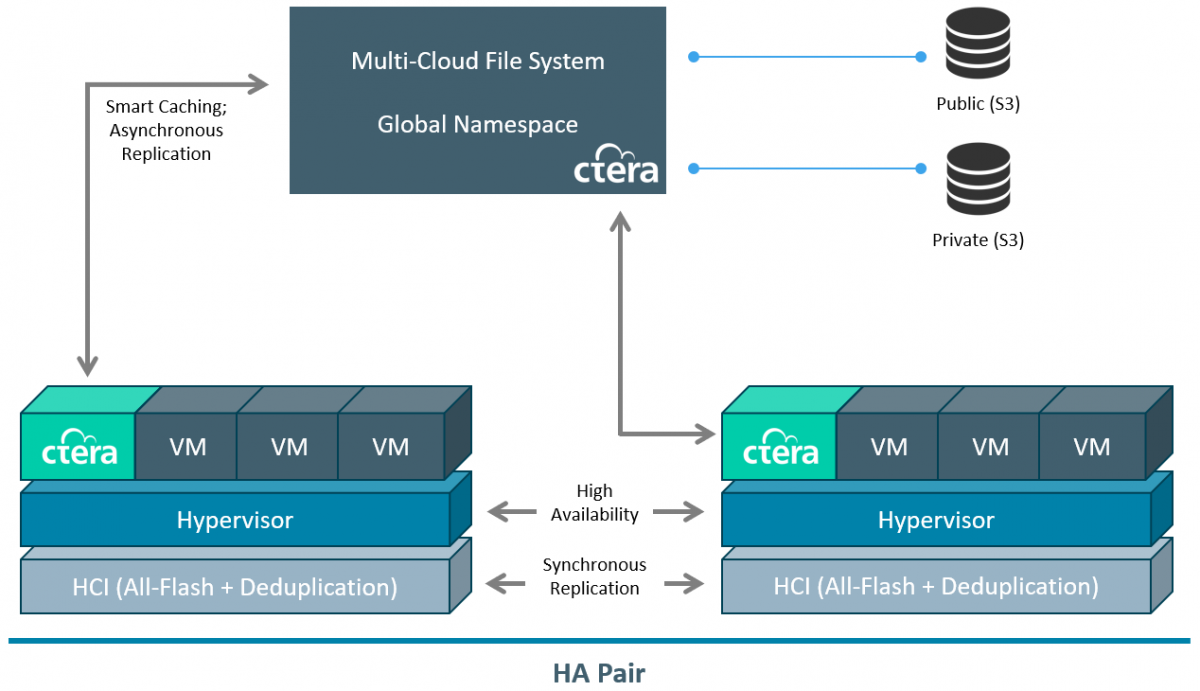CTERA Partners With HPE For X Series Hyperconverged Infrastructure For Edge Computing
CTERA has partnered with HPE to launch what it is calling the X Series appliance, designed to provide an easy-to-acquire edge presence of its global file services software.
The CTERA software runs as a virtual machine running on a SimpliVity based appliance using VMware as the hypervisor. The CTERA software then provides cloud-connected file services to systems running locally, either on the X Series appliance itself, or elsewhere in the local datacenter.

This setup is aimed squarely at remote office/branch office (ROBO) configurations where having a separate fileserver is a management headache. Sites contemplating a refresh can upgrade both the primary workload infrastructure and the file serving support infrastructure that often goes along with it. CTERA also talked up its ability to serve out VDI images to the local infrastructure.
“Today there's plenty of highly distributed data, usually outside the datacenter,” said Liran Eshel, CTERA CEO. Like many people, he sees data growth continuing, with most of it being at the edge rather than centralized in datacenters or clouds. “There's the growth in human generated data, particularly unstructured data like photos and videos,” he says, “But there's been an explosion in machine generated data.” CTERA sees that as an opportunity given its ten year history in file services.
A lot of ROBO workloads are being re-branded as Edge Computing now that the hype of the new term has caught on. Selling prosaic ROBO solutions is boring, while Edge Computing is new, exciting, and cool. That said, in standard ROBO deployment locations like retail chains, IoT sensors are being added to everything from fridges to CCTV systems. All that data needs to be stored somewhere and most of it is only temporarily useful out at the edge.
CTERA also likes to emphasize its security experience. “Security is a big concern to our customers,” says Eshel, “That's why our software can run on any public cloud, or private cloud, and still give you a global filesystem.” This self-hosting ability helps customers use cloud infrastructure as a resource layer that runs file services over-the-top, much like modern messaging systems run over-the-top of traditional phone networks.
Having HPE as a partner with an inherent motivation to assist with sales (by virtue of selling more hardware) makes this a fairly straightforward partnership. CTERA benefits from the increased sales force and an easier route to market, particularly one that, by its very distributed nature, is more expensive to access. HPE already has a presence here, so the cross-selling opportunity makes plenty of sense.
It also highlights to me how much HCI has become a mainstream deployment option, rather than a revolutionary architecture for changing the way everything is done. There are certain things HCI is good for, and branch offices that need some computer is a pretty solid one. SimpliVity made its name early on by being an easy-to-deploy solution for both primary compute and DR, and by adding extra services into an all-in-one solution it provides even more value in the same package.
Piling more software onto some unified HCI hardware makes sense, as does using a cloud-connected fleet of the same software across a set of remote locations. Ease of operations becomes very important as you scale, and there just isn't enough justification for substantial local variation of IT equipment for most organisations. It's the same logic as having the same brand of cash registers, pencils, and copy machines everywhere; there are economies of scale to be had and standardised operations helps efficiency.
The fact that the X Series runs VMware as its hypervisor will also please enterprises that have already made substantial investments into the operation of VMware environments. It's an easier sale if you can use the same trained operators and investments in automation out at the edge that you're already using in the core. I suspect this is going to provide a certain amount of castle-and-moat advantage to incumbents like VMware in coming years as automation really takes off.
This article first appeared in Forbes.com here.